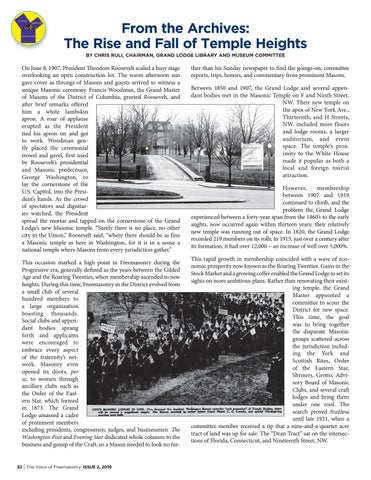On June 8, 1907, President Theodore Roosevelt scaled a busy stage overlooking an open construction lot. The warm afternoon sun gave cover as throngs of Masons and guests arrived to witness a unique Masonic ceremony. Francis Woodman, the Grand Master of Masons of the District of Columbia, greeted Roosevelt, and after brief remarks offered him a white lambskin apron. A roar of applause erupted as the President tied his apron on and got to work. Woodman gently placed the ceremonial trowel and gavel, first used by Roosevelt’s presidential and Masonic predecessor, George Washington, to lay the cornerstone of the U.S. Capitol, into the President’s hands. As the crowd of spectators and dignitaries watched, the President spread the mortar and tapped on the cornerstone of the Grand Lodge’s new Masonic temple. “Surely there is no place, no other city in the Union,” Roosevelt said, “where there should be as fine a Masonic temple as here in Washington, for it is in a sense a national temple where Masons from every jurisdiction gather.” This occasion marked a high point in Freemasonry during the Progressive era, generally defined as the years between the Gilded Age and the Roaring Twenties, when membership ascended to new heights. During this time, Freemasonry in the District evolved from a small club of several hundred members to a large organization boasting thousands. Social clubs and appendant bodies sprang forth and applicants were encouraged to embrace every aspect of the fraternity’s network. Masonry even opened its doors, per se, to women through ancillary clubs such as the Order of the Eastern Star, which formed in 1873. The Grand Lodge amassed a cadre of prominent members including presidents, congressmen, judges, and businessmen. The Washington Post and Evening Star dedicated whole columns to the business and gossip of the Craft, so a Mason needed to look no fur-
32 The Voice of Freemasonry ISSUE 2, 2019
ther than his Sunday newspaper to find the goings-on, committee reports, trips, honors, and commentary from prominent Masons. Between 1850 and 1907, the Grand Lodge and several appendant bodies met in the Masonic Temple on F and Ninth Street, NW. Their new temple on the apex of New York Ave., Thirteenth, and H Streets, NW, included more floors and lodge rooms, a larger auditorium, and event space. The temple’s proximity to the White House made it popular as both a local and foreign tourist attraction. However, membership between 1907 and 1919 continued to climb, and the problem the Grand Lodge experienced between a forty-year span from the 1860’s to the early aughts, now occurred again within thirteen years: their relatively new temple was running out of space. In 1820, the Grand Lodge recorded 219 members on its rolls; in 1915, just over a century after its formation, it had over 12,000 – an increase of well over 5,000%. This rapid growth in membership coincided with a wave of economic prosperity now known as the Roaring Twenties. Gains in the Stock Market and a growing coffer enabled the Grand Lodge to set its sights on more ambitious plans. Rather than renovating their existing temple, the Grand Master appointed a committee to scour the District for new space. This time, the goal was to bring together the disparate Masonic groups scattered across the jurisdiction including the York and Scottish Rites, Order of the Eastern Star, Shriners, Grotto, Advisory Board of Masonic Clubs, and several craft lodges and bring them under one roof. The search proved fruitless until late 1921, when a committee member received a tip that a nine-and-a-quarter acre tract of land was up for sale. The “Dean Tract” sat on the intersections of Florida, Connecticut, and Nineteenth Street, NW.













